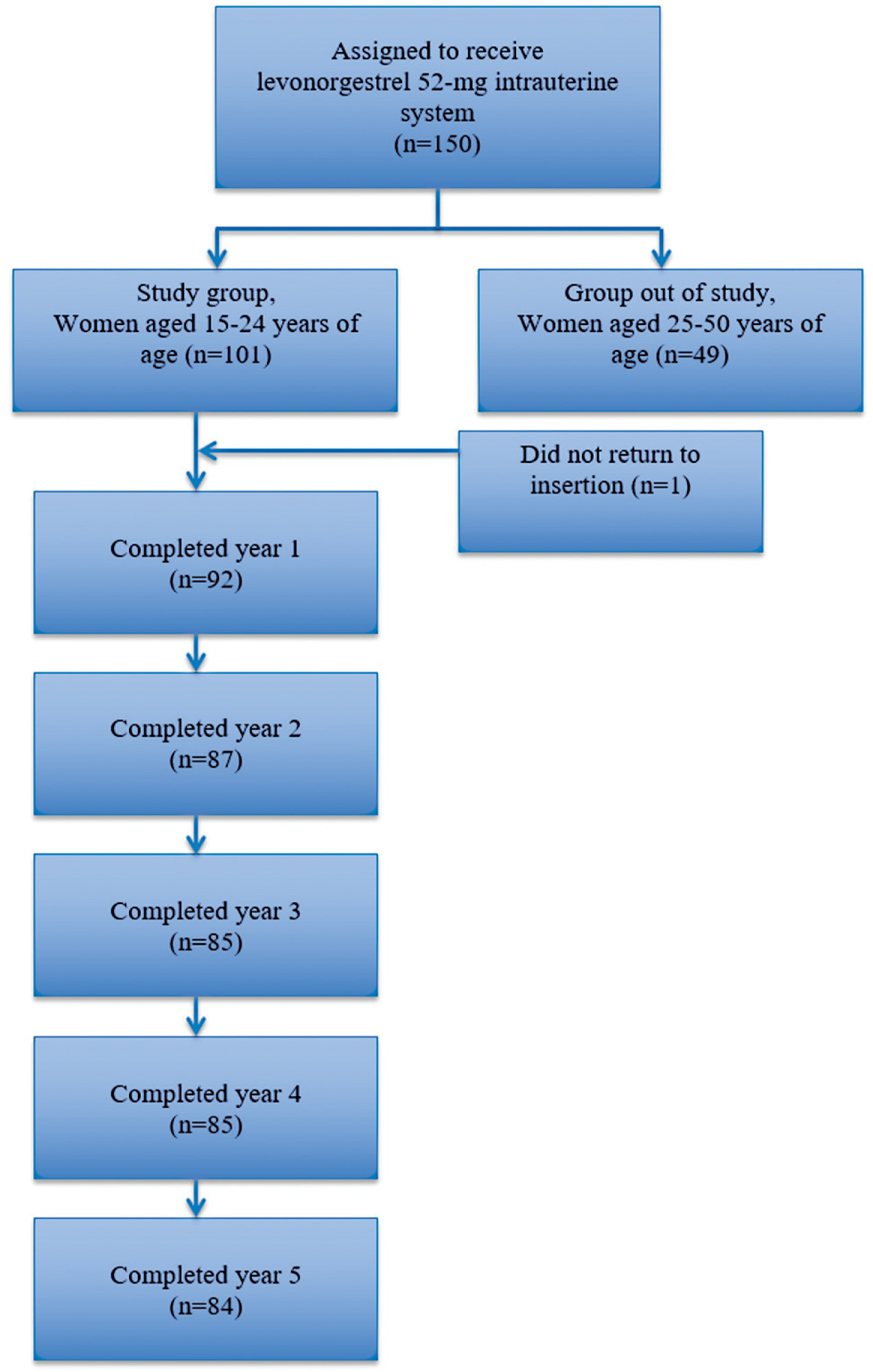Summary
Rev Bras Ginecol Obstet. 2023;45(11):654-660
To evaluate the continuation rates of the 52-mg levonorgestrel-releasing intrauterine system (LNG-IUS) during the first 5 years of use, reasons for its discontinuation, bleeding patterns, and new contraceptive choice after the 5th year, in adolescents and young women.
The present study was a 5-year prospective cohort conducted in a Family Planning Service of a tertiary hospital in Brazil. We selected 100 healthy women between 15 and 24 years old who used 52-mg LNG-IUS for contraception. The clinical follow-up of these women took place from June 2017 to December 2022. The study evaluated the continuation rates of the method, reasons for its discontinuation, bleeding patterns, and new contraceptive choice after the 5th year. Continuous data were reported as mean ± standard deviation (SD) and range (minimum-maximum). Categorical variables were described as percentages.
The continuation rates of LNG-IUS were 89.1% (82/92), 82.9% (72/87), 75.3% (64/85), 70.5% (60/85), and 64.2% (54/84) in the 1st, 2nd, 3rd, 4th, and 5th years of use, respectively. The main reason for discontinuation was acne (11/30). Amenorrhea rates were 50, 54.1, 39, 35.7, and 51.8% at 12, 24, 36, 48, and 60 months, respectively. All patients who completed the study and needed contraception after the 5th year opted for long-acting contraceptive methods (LARC).
The LNG-IUS showed high continuation rates in adolescents and young women in the first 5 years of use. Most patients who completed the study chose a LARC method after the 5th year.

Summary
Rev Bras Ginecol Obstet. 2022;44(4):391-397
To determine knowledge, attitude, and preventive (KAP) practices towards the SARS-CoV-2 (COVID-19) pandemic among women in reproductive age seeking to use copper or hormonal intrauterine devices (IUD/LNG-IUS).
We conducted a cross-sectional study in which we applied a questionnaire on 400 women about KAP practices on COVID-19 at the University of Campinas, Campinas, SP, Brazil, from May to August 2020.
The mean (±SD) age of the women was 30.8±7.9 years, and 72.8% of them reported being pregnant at least once. Most women (95%) had heard or read about COVID-19, and their main sources of information were television (91%) and government websites (53%). However, 53% of the women had doubts about the veracity of the information accessed.
Women without a partner and with>12 years of schooling had more information about COVID-19 and on its impact on new pregnancy, and those from high socioeconomic status had a higher chance of maintaining physical distance. Safety, effectiveness, comfort, and absence of hormone in the contraceptive method (in the case of TCu380A IUD) were the main reasons for the participants to seek the service during the pandemic, and the possibility to stop menstrual bleeding was the main reason to choose the LNG-IUS.
Summary
Rev Bras Ginecol Obstet. 2020;42(4):194-199
Changes in bleeding patterns could influence the decisions of healthcare professionals to change the levonorgestrel-releasing intrauterine system (LNG-IUS) before 7 years of use, the recommended period of extended use. We evaluated changes in the bleeding patterns of users of the 52 mg LNG-IUS at the end of use of the first (IUS-1) and during the second device (IUS-2) use.
We performed an audit of the medical records of all women who used two consecutive LNG-IUSs at the Family Planning clinic. We evaluated the sociodemographic/gynecological variables, the length of use, and the bleeding patterns reported in the reference periods of 90 days before removal of the IUS-1 and at the last return in use of IUS-2. We used the McNemar test to compare bleeding patterns. Statistical significance was established at p < 0.05.
We evaluated 301 women aged (mean ± SD) 32 (±6.1) years, with lengths of use of 68.9 (±16.8) and 20.3 (±16.7) months for the IUS-1 and IUS-2, respectively. No pregnancies were reported. Bleeding patterns varied significantly among women who used the IUS-2 for ≥ 7 months to 6 years when compared the bleeding patterns reported in IUS-1 use. Eighty-nine out of 221 (40%) women maintained amenorrhea and infrequent bleeding; 66 (30%) evolved to bleeding patterns with light flow, and 66 (30%) maintained or evolved to heavy flow patterns (p = 0.012). No differences were observed among the 80 women with ≤ 6 months of use.
Changes in bleeding patterns occur during the use of LNG-IUS and should not be decisive for the early replacement of the device.